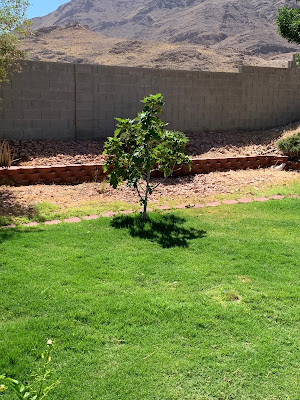Q. About a year ago your newspaper column had a clip
about stopping annual weeds & it’s in your column in the RJ this past
Saturday. I had my yard re-rocked & took your advice over the advice of the
landscaper who wanted to put down a screen to stop weeds. I paid extra to have
him put down a 3 inch layer of rocks. I believe last year you said 3 inches
& this year 4. So, now I have a lot of weeds in all of the rock areas!
What happened?
Black plastic mulch under a rock mulch and eventual unsightliness.
A. Great questions and I apologize for any
misunderstanding I may have created. I don’t have any pictures to go on so I’m
using my imagination. Let me tell you my thoughts about this.
Do you know that the time (and money) spent to control weeds beats out time (and money) spent to control insects or diseaseor both of these combined? It's true in agriculture, too. Weed control is timely and expensive.
Here plastic is applied under rock mulch bordering a lawn. The plastic is suffocating the roots of Italian cypress and causing it to yellow.
There is some research done on the use of thicker rock mulch versus using a landscape fabric (sometimes called a weed barrier and you call it a screen). There are a number of recommendations about what to do when laying down any type of much whether it is rock or wood. The information I see on using both is either from marketing and sales of landscape fabric or from landscaping companies promoting it.
Landscape fabric starting to poke its head out from under rock mulch in a couple of years.
Using landscape fabric under rock or woodchip mulch looks good in the beginning.
Pro landscape fabrics
The Spruce - How to install landscape fabric
Bob Villa - Landscape Fabric 101
There are some sites that are against its use. This can be from informational sites or landscapers. Its not a "magic bullet" when it comes to controlling landscape weeds.
Con landscape fabrics
Plenty
of contradictory information out there and I think the main reason for
using landscape fabrics AND mulch is hope. This includes landscapers as well.
Black plastic under rock mulch and planting.
First of all, don’t ever
expect total weed control from anything whether it’s by mulch, a weed fabric or
both. Wherever water is applied there will be weed growth. The most common
places whether there is fabric applied are not is where the drip irrigation is applied.
Weed
barriers do nothing to prevent bermudagrass, nutgrass and many other weeds from
growing.
Whenever installing mulch, whichever method you use, take the time to kill weeds first before using landscape fabric or not.
Spray marker (paint) is used to mark where weed control spray is applied to a landscape to reduce spraying weeds twice.
Origin of Landscape Fabrics
Weed control barriers had their start in commercial agriculture.
It was then adopted to landscapes.
Here black plastic mulch is used as a temporary mulch for weed control and warming the soil early for lettuce production in Kosovo. Straw is used between the beds as a temporary mulch.
The
most effective depth for rock to cover a surface is at least 2 inches deep.
Nothing is gained by having the rock deeper than four inches. The problem
in making a rock mulch two inches deep. evenly, is it takes precision. Higher
areas are one inch deep and low spots are three inches deep. The best choice is
probably three inch depth but certainly not more than four! That's a waste of money.
Best
depth for rock mulch
Hence, landscape fabrics are not recommended for weed
control practices in landscape planting beds.
Non-chemical
Weed Control Strategies for Nurseries and Landscapes: Part I
Reason for Justifying Landscape Fabric
A reason for applying landscape fabric is weed control.
One reason for applying a mulch is weed control. They are supposed to do the same thing. Why apply two things for the
same reason?
Applying rock mulch is a permanent layer. Landscape fabrics or weed
barriers are temporary weed barriers. You are applying a temporary weed control barrier under
a permanent layer. Do you see the problem that will arise if the temporary barrier fails? This doesn’t make sense to me. Using two things for the
same purpose? And applying something temporary under something permanent?
What to do?
If you have it under rock or wood mulch then it is there. Nothing you can do about it but it will be a big job if it has to be removed because of unsightliness. Hopefully it is not a solid sheet of plastic but a fabric that allows air and water to plant roots. That's better but it can still be unsightly over time.
Hand weeding. Most, probably about 90% of the weeds that you see at first will be annual. They can be easily removed with some hand labor and a hoe before they flower. Another option (one that I use with rock mulch) is a fire weeder like Red Dragon and propane. Make sure your municipal ordinances allow its use first.
There are weed control chemicals you can use
to control weeds around your landscape plants without hurting them. Try
applying fusilade weed control products for grass control growing in non grassy landscape plants
if bermudagrass is the problem. Look for fusilade (fluazifop-p-butyl) to be listed in the active ingredients on the label. In some cases the product is simply called Fusilade. (I agree its a lousy name to remember).
Permanent Weed Control
Permanent control of weeds is impossible but you can reduce the amount of time you spend weeding. Persistence.
1. Never let weeds flower. This makes seed. "One year weeds, seven years of weeding." (old gardening adage). Remove them before that happens.
2. Remove weeds when you first see them. It will begin starving your worst weed problems out and you will see a reduction in your efforts the first months of your efforts! If you do this, the amount of weeding time spent on your property will become less. It will never be nothing, but it will be less.



































 A.
A. 










